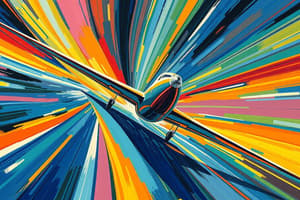Podcast
Questions and Answers
What is the primary focus of aerodynamics?
What is the primary focus of aerodynamics?
Who laid the foundations of aerodynamics by observing birds and seeking to understand their flight ability?
Who laid the foundations of aerodynamics by observing birds and seeking to understand their flight ability?
Which century saw a more systematic application of aerodynamic principles towards aviation?
Which century saw a more systematic application of aerodynamic principles towards aviation?
What did the Wright Brothers build that was the world's first successful powered aircraft?
What did the Wright Brothers build that was the world's first successful powered aircraft?
Signup and view all the answers
Who provided insights into lift forces and drag through his laws of motion and universal gravitation?
Who provided insights into lift forces and drag through his laws of motion and universal gravitation?
Signup and view all the answers
What location near Kitty Hawk, North Carolina, saw the successful achievement of powered and controlled flight in 1903?
What location near Kitty Hawk, North Carolina, saw the successful achievement of powered and controlled flight in 1903?
Signup and view all the answers
What are the three horizontal surfaces known as in early aviation design?
What are the three horizontal surfaces known as in early aviation design?
Signup and view all the answers
What is the purpose of an airfoil in aviation?
What is the purpose of an airfoil in aviation?
Signup and view all the answers
Why were wind tunnels significant for early aviators?
Why were wind tunnels significant for early aviators?
Signup and view all the answers
Which aircraft became the first manned flying machine to take off under power from level ground?
Which aircraft became the first manned flying machine to take off under power from level ground?
Signup and view all the answers
What foundational principles does aerodynamics encompass?
What foundational principles does aerodynamics encompass?
Signup and view all the answers
What was the contribution of the Wright brothers to aviation innovation?
What was the contribution of the Wright brothers to aviation innovation?
Signup and view all the answers
Study Notes
First Flight: Exploring Aerodynamic Milestones
The concept of human flight has fascinated us since antiquity, inspiring artists, engineers, mathematicians, and dreamers alike. But it wasn't until December 17th, 1903, near Kitty Hawk, North Carolina, that humanity successfully achieved powered and controlled flight through the Wright Brothers' efforts. In this exploration of first flight, we will delve into the critical role aerodynamics played in bringing this momentous undertaking to fruition.
Early Understandings of Lift and Drag
Aerodynamics is the study of air in motion around objects; its foundations were laid by scholars like Leonardo da Vinci, who observed birds and sought to understand their ability to fly centuries ago. Sir Isaac Newton contributed significantly with his laws of motion and universal gravitation, providing insights into lift forces and drag. However, it was not until the late nineteenth century that scientists and inventors began applying these principles more systematically toward aviation.
Wilbur and Orville Wright drew upon knowledge from prior researchers and experimented extensively with kites and gliders before building what they called their Flyer—the world’s first successful powered aircraft. Their design employed fixed wings and three horizontal surfaces, known as elevators, rudders, and ailerons (collectively referred to today as control surfaces), which allowed them to manipulate pitch, yaw, roll—in short, all six degrees of freedom inherent to flight.
Wing Design and Airfoils
One essential element in early aerodynamic studies concerned wing shape—or 'airfoil.' As every pilot knows, certain shapes create lift while minimizing drag, enabling planes to travel through the air efficiently. Thomas Edison even patented one such airfoil shape! Wings designed using these concepts allow objects to move through the atmosphere with enhanced performance.
To illustrate, imagine two triangles facing each other head-to-head. One triangle has flat sides, and the other slanted ones. If you skim your hand across both, you'll feel resistance when encountering the angled surface of the second triangle because it pushes against the flow of air (lift) rather than just passing over it (drag).
Wind Tunnel Testing
Long before the advent of large jetliners or supersonic fighters, wind tunnels offered pioneering aviators a means to test ideas in a controlled environment without risking lives. By measuring pressure differences along model aircraft surfaces, engineers could better comprehend how various configurations performed under different conditions. For instance, Langley's unmanned Aerodrome No. 5 became the first manned flying machine to take off under power from level ground on January 6th, 1903, due in part to extensive wind tunnel testing conducted by Samuel Pierpont Langley and Charles Manly.
In conclusion, understanding aerodynamics represents one cornerstone in humankind's quest towards achieving human flight. From ancient philosophical musings to modern engineering marvels, our progress owes itself greatly to the discipline that encompasses lift, drag, and fluid dynamics. And it started with the Wright brothers' remarkable demonstration that took place nearly a hundred years ago and continues to drive innovation in aviation through the present day.
Studying That Suits You
Use AI to generate personalized quizzes and flashcards to suit your learning preferences.
Description
Explore the key aerodynamic milestones that led to the first successful powered and controlled flight by the Wright Brothers in 1903. Learn about early understandings of lift and drag, wing design, airfoils, and the significance of wind tunnel testing in aviation history.




